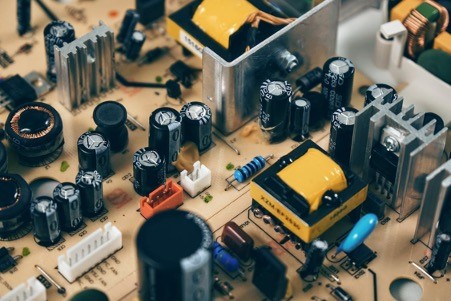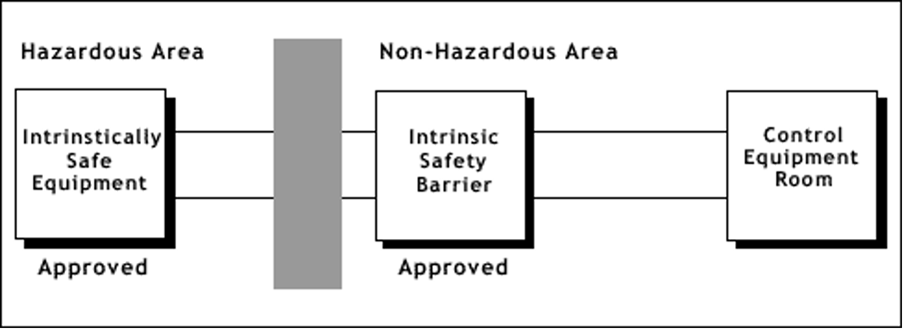
Intrinsic Safety
Essential Facts About Flammable Gases
Read a summary using the INOMICS AI tool
Electrical devices often produce sparks and heat through normal operation, which can pose a risk in hazardous environments. To mitigate this, techniques such as intrinsic safety are implemented to prevent these devices from becoming a source of ignition.
This article will clarify the concept of intrinsic safety, providing a clear definition and comparing it with alternative safety measures like flameproofing, to give a comprehensive understanding of how safety is maintained in potentially dangerous settings.
The Meaning of Intrinsically Safe
Engineers tasked with ensuring safety in hazardous areas often design devices to be intrinsically safe. This means that the devices are incapable of producing sparks or heat that could set off an explosive atmosphere. This protection method, often referred to as Ex 'i', involves limiting both the thermal and electrical energy to levels that cannot cause ignition.
To adhere to Ex 'i' standards, manufacturers need to take several key factors into account:
• Temperature Control: Implementing devices like current limiting resistors and fuses helps maintain safe component temperatures.
• Spark Reduction: By limiting the energy available in the system, the potential for internal sparking is minimized.
• Spacing Management: Proper spacing between components and tracks, along with ensuring isolation, is vital to prevent dust or other substances from causing a short circuit.
Ultimately, the goal of intrinsic safety design is to create electronic circuits that are inherently unable to become ignition sources in environments where there is a constant threat of explosive gases or dust.
Without these measures, common components like certain capacitors and inductors can pose risks due to high voltage, which is why most standard PCBs are not compliant with intrinsic safety standards.

The Presence of Flammable Gases or Vapors
Flammable gases or vapors, such as propane or hydrogen, can be found in many industrial environments. If these gases leak and mix with the air, they create an explosive mixture. A standard PCB, which might emit sparks or heat, has the potential to ignite this mixture, leading to a fire or explosion. This is why areas where flammable substances are present must be carefully managed to prevent such risks.
Intrinsically Safe vs. Flameproof
Hazardous area designers utilize flameproof, or Ex ‘d’ protection methods as another strategy to prevent explosions. This type of equipment is built to withstand explosions by containing any possible fires or explosions within its structure, offering a different approach to safety compared to intrinsic safety.
Selecting the most effective protection method depends on the context, as each has distinct applications. They can be used together, and an analysis of their respective advantages and disadvantages can guide their appropriate use.
The Advantages and Disadvantages of Flameproof Equipment
Flameproof equipment, designed with a simple enclosure, is well-suited for high-power applications. However, this design can lead to increased weight and cost of the equipment. Users are cautioned against opening the enclosure when the equipment is operational, as this could pose a risk.
Maintenance can be complex, and it's vital to avoid any damage to the enclosure since such damage could compromise safety in hazardous environments. Employing the Ex 'd' protection method, flameproof equipment is typically selected for stationary machinery installations.
The Advantages and Disadvantages of Intrinsically Equipment
Intrinsic safety is a cost-effective option for the end-user, offering the advantage of not needing special cabling, and maintenance can be conducted without shutting down the plant operations. However, it is limited to low-power equipment like smoke detectors, beacons, and portable devices.
A significant downside is the need to redesign PCBs, which can increase engineering costs. As a result, to be cost-effective, intrinsic safety often necessitates production at a high volume.
Intrinsic Safety Barriers
Understanding the mechanisms for maintaining safety in potentially explosive environments is crucial for hazardous area design. One key element in this design is the intrinsic safety barrier.
These barriers play a vital role in controlling and limiting the energy transmitted between safe and hazardous zones, ensuring that any electrical activity does not trigger an explosion. Below, we explore how intrinsic safety barriers function and the types available for industrial safety systems.
Isolated Barriers: These provide galvanic isolation, which helps in avoiding signal distortion and protecting against surges in measurement and control circuits. They also perform signal conversion, standardization, and division.
Zener Barriers: Known for their function as shunt-diode safety barriers, they block high energy levels from moving from neutral to hazardous areas, ensuring that only safe energy levels are present.

Intrinsic Safety and ATEX
In the domain of hazardous area design, understanding the relationship between intrinsic safety and the ATEX directive is essential. Both are integral to ensuring safety in environments prone to explosions. The ATEX directive establishes precise safety requirements for managing explosive atmospheres, with intrinsic safety being a protection method within this framework. In other words, intrinsic safety is part of the ATEX 153 directive.
Different Terminologies
In industries dealing with hazardous areas, various terms are often used interchangeably to describe products certified for use in potentially explosive atmospheres. These certifications, collectively referred to as "Ex certifications," signify the product's suitability for such environments. They can vary based on regions, with examples including ATEX certification in the EU, IECEx on a global scale, or UKCA/UKEX in the United Kingdom. Despite the diverse terminology, they all share the common goal of ensuring safety in hazardous settings.
However, it's important to note that the use of terminology can vary by region and may lead to some confusion. For example:
• In the United Kingdom, the term 'intrinsically safe' is commonly used to refer to Ex-certified products. However, this can be misleading as it doesn't necessarily mean that the product employs intrinsic safety as a protection method.
• In the United States and some other countries, people often use the term 'explosion-proof' to describe Ex-certified products. This terminology can also be misleading, as it might suggest that the product can withstand an explosion, which is not the case. These products are designed to prevent the formation of ignition sources.
In summary, when individuals refer to a product as 'Intrinsically Safe,' 'Explosion Proof,' 'Flameproof,' or 'Ex Certified,' they typically mean a product that is suitable for use in explosive atmospheres, even though the specific terminology and its implications may vary.
Intrinsically Safe vs. Non-Incendive: Categorizing
By now, you've learned that 'intrinsically safe' can have dual meanings, signifying a protection method or suitability for use in hazardous areas. Moreover, 'Intrinsically Safe' serves as a categorization term for equipment in hazardous areas, adding complexity to its interpretation.
As you're aware, hazardous areas are classified into zones based on their nature and associated risks. Intrinsically safe products find common usage in Zone 1 (gas) and 21 (dust), which are considered more hazardous than Zone 2 (gas) and 22 (dust), where non-incendive products hold certification.
In conclusion, when a product is labeled as intrinsically safe, explosion-proof, or flameproof, it's vital to ensure that the certification aligns with your specific location and hazardous area requirements. If any doubts or clarifications are needed, please feel free to contact us.
The Takeaway
We trust that this article has provided you with a comprehensive understanding of 'intrinsically safe,' intrinsically safe equipment, and related concepts. Ultimately, every company is dedicated to safeguarding individuals in hazardous environments against explosion risks stemming from combustible dust or flammable liquids.
In brief, 'Intrinsically Safe' denotes a protection method (Ex 'i') and is frequently used interchangeably with 'explosion-proof' and 'flame-proof' in the industry. Notably, it serves as a specific categorization for equipment suitable for the more hazardous zones 1/21, distinct from the less hazardous zones 2/22.
For more information on these topics, please read the full article on cobic-ex.com: ‘What does intrinsically safe mean’ and ‘what is the difference between intrinsically safe and non-incendive?’
Image Credits: Pexels - Tom Fisk / Pexels / Ex.Machinery
We would like to thank Armadex Explosion Protection BV for their support in producing this blog article for New Engineer.
-
- Konferenz
- Posted 3 weeks ago
44th RSEP International Conference on Economics, Finance and Business
Between 27 Nov and 28 Nov in Rome, Italien
-
- Professor Job
- Posted 1 week ago
Professor of Economics, Tenured - Tenure/Track (Open-Rank)
At New York University Abu Dhabi in Vereinigte Arabische Emirate
-
- Konferenz
- Posted 4 days ago
45th RSEP International Multidisciplinary Conference
Between 4 Feb and 5 Feb in Lisbon, Portugal











